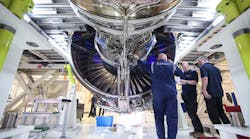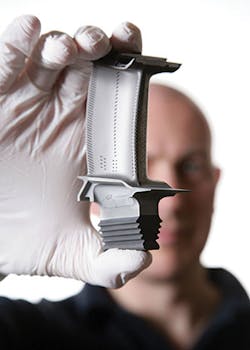If you want to supply castings to aircraft builders and manufacturers of critical aerospace systems, including jet engines, you’re on your own. So demanding are the quality, performance, and reliability standards for those parts that the certification process can drag on for months, or longer. More than that, the demand is so great at the moment that the buyers have an even stronger bargaining position than they might otherwise hold. It makes sense that some of the most important supply programs for castings in civil and military aerospace are being handled by new, in some cases greenfield, investment casting operations.
Alcoa will complete construction soon on the 320,000-sq.ft. expansion of its investment casting operation in LaPorte, IN, where it manufactures compressors and turbines for aerospace and industrial gas operations. The addition is intended to expand Alcoa’s product range to include larger-dimension parts in nickel-based superalloys, as structural engine components for larger aircraft, including the various new commercial jets in development by Airbus and Boeing, and military aircraft.
Similarly, Alcoa is nearing completion of a $25-million expansion of investment casting capability at its Hampton, VA, foundry to produce a new range of aerospace parts. It is installing a new manufacturing line and modifying some current equipment to cast airfoil blades for jet engines. The foundry already produces airfoils for industrial gas turbines and large structural castings, in nickel and titanium alloys.
Four years ago, Chromalloy Castings started up a, $30-million investment casting plant in Tampa where it produces single-crystal and equiaxed turbine blades and vanes for aerospace and IGT engines, in nickel- and cobalt-based super-alloys, and some stainless steel grades. The 115,000-sq.ft. plant replaced a former operation that Chromalloy determined had insufficient capacity to produce the volume and range of castings for OEMs and for the operations within its own global organization of turbine engine supplies and services.
About a year later, Chromalloy installed a 40,000-sq.ft., ceramic core plant adjacent to the foundry.
Of course, Lockheed Martin’s F-35 Lightning II stealth fighter jet has spurred dozens of production programs, including two new foundries specially built to produce aluminum-beryllium investment castings: IBC Engineered Materials started up its new foundry in Wilmington, MA, in 2011, and Materion Beryllium & Composites started investment casting in Elmore, OH, in 2013. Each is supplying near-net-shape parts in proprietary AlBe alloys to Lockheed for a critical housing of the F-35’s targeting system.
Among the most important development projects was carried out by one of the aerospace industry’s top OEMs. Jet engine builder Rolls-Royce Plc opened a £100-million (est. $172 million), 18,000-sq.m. plant in England earlier this year to cast discs for its Trent XWB jet engines. The new installation will reach full production capacity — 2,500 fan and turbine discs annually — in 2016.
“Rolls-Royce is committed to investing for future growth in order to deliver for our customers,” stated Tony Wood, president of Aerospace for the engine builder. “We invested £687 million (est. $1.2 billion) in facilities and equipment around the world last year. This facility will use groundbreaking manufacturing techniques to produce discs for our Trent engines, including the world’s most efficient aero engine, the Trent XWB.”
The new foundry is adopting some manufacturing methods developed at the U.K.’s Advanced Manufacturing Research Centre (AMRC), part of a network of research centers working with British businesses to commercialize new manufacturing technologies.
Rolls also developed a specialty machining operation nearby, to complete production of the critical engine parts.
Fan discs and turbine discs are core components of turbofan jet engines. The Trent XWB is an engine that Rolls developed specifically for the Airbus A350 XWB, and orders already have reached 1,600, with many more sure to follow based on the success of the Airbus program. The A350 XWB is a version of Airbus’ new long-range, dual engine wide-body jet, designed to carry up to 550 passengers, depending on the model variant and seating arrangement.
Jet engines are Rolls-Royce’s signature product, and the new foundry in Rotherham is producing some of its engines’ critical parts. Fan discs are installed in the front, air-intake part of the engine, and are the element to which fan blades are attached — typically, 20 blades per engine. They rotate at a speed estimated as 2,700 times per minute to move 1.25 metric tons of air per second. They are designed to remain in service for over 20 years.
Turbine discs are the components to which turbine blades are attached, in the center (i.e., the hottest part) of the engine. Thus, they must be produced in a high-strength material to endure the heat and pressure created during flight. The material is formed from a high-density powder metal that is processed and machined to extraordinary accuracy, “a fraction of the thickness of a human hair,” according to Rolls-Royce.
Each turbine disc is fitted with 68 turbine blades, and each of these blades generates power equivalent to a Formula 1 racecar, again according to Rolls’ description.
In operation, each high-pressure turbine engine rises to 1,700°C, hotter than the melting point of the blade material. As such, each blade is coated with a specially developed ceramic, and cooled with air that passes through the discs out of the engine chamber through a series of holes in the blade — each hole precisely placed and precisely drilled.










